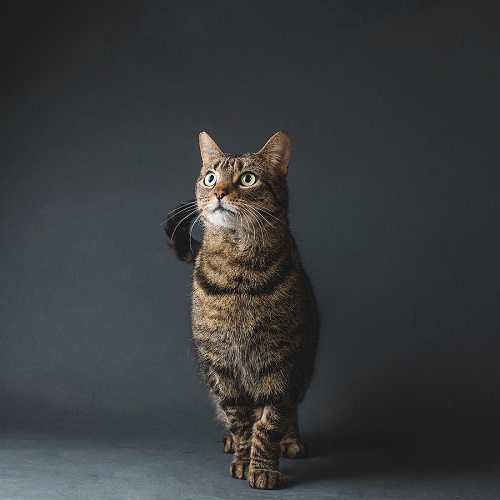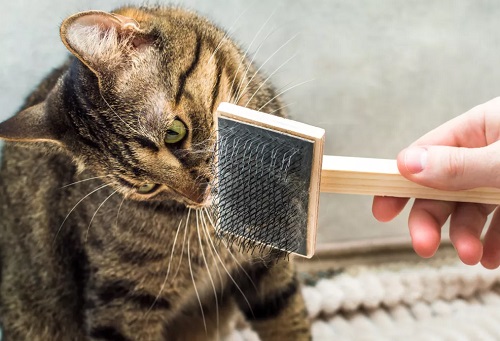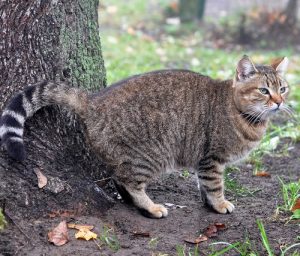Do Tabby Cats Shed A Lot? Read this article to learn more about this cat-type and their shedding habits.
Tabby cats are known for their striking striped patterns, playful personalities, and vibrant energy. But one aspect often concerns potential cat parents: ” Do Tabby Cats Shed A Lot?” Let’s find out below.
Do Russian Blue Cats Like Water? Find out here
Introduction To Tabby Cats

Tabby cats are one of the most popular and recognizable cat types worldwide. They are not a specific type but rather a coat pattern that can be found in various breeds. Tabby cats are known for their distinctive markings, which include stripes, swirls, and spots on their fur.
Originating from domestic cats with wild ancestors, tabby patterns have been observed for thousands of years. The term “tabby” actually comes from the French word “tabis,” which refers to a type of silk with a wavy or watered pattern. This reflects the resemblance of a tabby cat’s coat to the wavy texture of this silk fabric.
Tabby markings can be found in a wide range of cat breeds, including the American Shorthair, Maine Coon, Bengal, Abyssinian, and many others. This means that tabby cats can vary in size, body shape, and overall physical characteristics depending on their breed. They come in different colors (brown, gray, orange, and silver) and coat patterns. Each pattern has its own unique charm and appeal.
In addition to their striking appearance, tabby cats are known for their friendly and affectionate personalities. They are often described as being social, playful, and outgoing. Tabby cats can make wonderful companions and are well-suited for households with children and other pets.
Understanding the Shedding Process in Cats
Shedding is a natural process for kitties, as it allows them to replace old or damaged hair with new growth. Here are some key points about the shedding process:
- Seasonal Shedding: Cats typically experience two major shedding seasons—spring and fall. As the seasons change, their coats adapt to the temperature variations. During spring, they shed their thick winter coat to make way for lighter summer coats, and in the fall, they shed their summer coat to prepare for thicker winter coats.
- Hair Growth Cycle: The shedding process is directly linked to the hair growth cycle of cats. They have three stages in their hair growth cycle: anagen (active growth), catagen (transitional), and telogen (resting). The shedding occurs during the telogen phase when old hairs are shed to make room for new ones.
- Individual Variation: The amount and frequency of shedding can vary among cats. Factors such as breed, genetics, age, health, and environmental conditions can influence shedding patterns. Some kitties may shed more than others, even within the same breed.
- Regular Grooming: Regular grooming plays a crucial role in managing shedding in cats. Brushing your cat’s coat helps to remove loose and dead hair, preventing it from accumulating in your home.
- Hairballs: Shedding can contribute to the formation of hairballs in cats. When kitties groom themselves, they ingest loose hair, which can accumulate in their digestive tract and form hairballs. Regular brushing and providing specialized cat hairball remedies can help minimize the occurrence of hairballs.
- Health Concerns: While shedding is a normal part of a cat’s life, excessive or sudden changes in shedding patterns can be a sign of underlying health issues. If you notice significant hair loss or other abnormal symptoms, consult a vet.
Do Tabby Cats Shed A Lot?

The answer to the question -“do tabby cats shed hair?” is yes! However, they can vary in their shedding habits. In general, they do not shed more or less than cats of other coat patterns or breeds.
How much do tabby cats shed? Well, the shedding amount and frequency primarily depend on individual factors, which we will see below.
Do Orange Tabby Cats Shed A Lot?
Orange tabby cats, like other tabby cats, do not necessarily shed more or less than felines of other coat colors or patterns. The amount of shedding can vary among orange tabby cats, just as it can among kitties of different colors or patterns.
Factors That Influence Cat Shedding
- Breed: Different cat breeds have varying coat types and lengths, which can affect shedding. Some species, such as the Persian or Maine Coon, have long, dense coats and may shed more compared to breeds with shorter or less dense coats.
- Coat Type: The type of coat a cat has, whether it is short, medium, or long, can impact shedding. Cats with longer coats tend to shed more because they have more hair follicles. Additionally, felines with double coats, which have a dense undercoat and a longer outer coat, may shed more during seasonal transitions.
- Hormonal Influences: Hormonal changes, such as those that occur during pregnancy or after giving birth, can affect a cat’s shedding patterns. Spaying or neutering a cat can also impact its hormone levels and potentially alter shedding habits.
- Health and Diet: A cat’s overall health and nutrition can impact its shedding. Cats with underlying health issues or nutritional deficiencies may experience excessive shedding or changes in their coat condition.
- Stress and Anxiety: Cats may shed more when they are stressed or anxious. Changes in the environment, routine, or the presence of other pets can contribute to increased shedding.
- Climate and Temperature: Cats may shed differently depending on the climate they live in. Cats in warmer climates might shed more throughout the year to regulate their body temperature, while cats in cooler climates experience more shedding during seasonal transitions.
Managing Shedding in Tabby Cats: Tips and Techniques

- Regular Brushing: Brush your tabby cat’s coat on a consistent basis to remove loose and dead hair. This helps prevent the hair from ending up on furniture, carpets, and clothing. Choose a brush or comb that is suitable for your cat’s coat type and gently brush in the direction of hair growth.
- Use a De-shedding Tool: Consider using a De-shedding tool specifically designed to reduce shedding in cats. These tools effectively remove loose hair from the undercoat, which is where most shedding occurs. Be gentle while using the device to avoid causing any discomfort to your cat.
- Bathe Your Cat: Occasionally bathing your tabby cat can help remove loose hair and reduce shedding. Use a cat-friendly shampoo, and make sure to rinse the coat to avoid skin irritation. However, it’s important not to over-bathe your cat, as excessive bathing can dry out their skin and lead to increased shedding.
- Provide a Healthy Diet: A nutritious diet plays a crucial role in maintaining a healthy coat. Ensure that your tabby cat’s diet is balanced and provides essential nutrients, including fatty acids, which contribute to a healthy coat. Consult with a veterinarian to determine the best diet for your cat’s specific needs.
- Control Environmental Factors: Keep your home at a comfortable temperature to help reduce excessive shedding. Avoid exposing your tabby cat to extreme heat or cold, as these conditions can impact their shedding patterns.
- Address Underlying Health Issues: If you notice excessive shedding or changes in your tabby cat’s coat quality, consult a veterinarian. Underlying health issues, allergies, or skin conditions could contribute to abnormal shedding.
- Stress Management: Minimize stressors in your cat’s environment, as stress can contribute to increased shedding. Provide a calm and safe space for your tabby cat to promote relaxation.
Shedding Pattern Variations Among Tabby Coat Types
- Classic Tabby: The classic tabby coat features bold, swirling patterns with an iconic “M” shape on the forehead. Shedding patterns may vary, but overall, classic tabbies tend to shed moderately with consistent hair distribution.
- Mackerel Tabby: Mackerel tabbies display narrow, vertical stripes that run along their body. Shedding tendencies can vary among individuals, with some mackerel tabbies shedding lightly and others shedding more moderately, typically maintaining a relatively even coat.
- Ticked Tabby: Ticked tabbies have fur with multiple bands of colors on each hair, resulting in a speckled appearance. Shedding patterns in ticked tabbies can vary, but they are generally known to shed less compared to other tabby coat types, owing to the unique hair structure.
- Spotted Tabby: Spotted tabbies exhibit distinct spots or rosettes on their coat, creating an eye-catching pattern. Shedding behavior among spotted tabbies may vary, with some individuals shedding lightly while others may shed moderately, often maintaining a balanced coat appearance.
- Patched Tabby: Patched tabbies have irregular patches of color on their coat, giving them a charming and unique appearance. Shedding patterns in patched tabbies tend to be similar to other tabby types, with moderate shedding that requires regular grooming to prevent matting and maintain coat health.
Do Tabby Cats Shed A Lot? Quick Takeaways
- Tabby cats are popular and recognizable, known for their distinctive coat patterns.
- Shedding is a natural part of a cat’s hair growth cycle, and tabby cats shed like any other kitty.
- Factors such as breed, coat type, hormonal influences, health, and climate can influence shedding in cats.
- Regular grooming, including brushing and using de-shedding tools, helps manage shedding.
- Providing a healthy diet and keeping the home clean can reduce shedding.
- Addressing underlying health issues and minimizing stress can also impact shedding.
- Tabby cats, including orange tabbies, do not necessarily shed more or less than other cats.
- Excessive shedding or changes in shedding patterns should be evaluated by a veterinarian.
- Managing shedding in tabby cats involves regular grooming, maintaining a healthy diet, and creating a stress-free environment.
- Tabby coat types exhibit diverse shedding patterns, with classic tabbies shedding moderately, mackerel tabbies shedding lightly to moderately, ticked tabbies shedding less, spotted tabbies shedding lightly to moderately, and patched tabbies shedding moderately.



